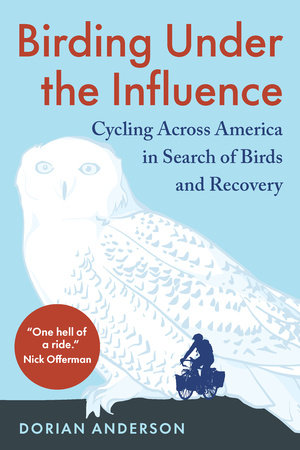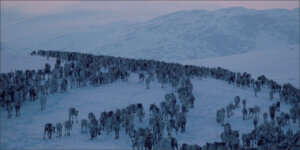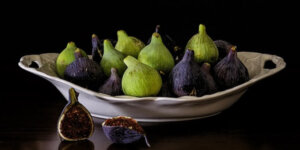Starting A Big Year of Birdwatching: Bicycle Beginnings

At a personal and professional crossroads, a man reset his life and found sobriety, love, and 618 bird species, cycling his way to a very Big Year. Join him on his journey as he recounts beginning his Big Year on bicycle!
The following is an excerpt from Birding Under the Influence by Dorian Anderson. It has been adapted for the web.
Starting A Big Year of Birdwatching
Staring out the kitchen window and into the predawn darkness, I recoiled when I glimpsed the outdoor thermometer.
Twenty-nine degrees? Sure. Nineteen degrees? Maybe. But nine degrees? Kill me now.
Incredulous, I shuffled toward the back door and stuck my bedhead out. Mother Nature satisfied my curiosity with an icy, backhanded slap across my face, and I slammed the portal shut before she could extend her sub-freezing shellacking.
Nine degrees it is. Damn.
A Chilly Beginning
I knew starting my bicycle Big Year in Massachusetts could expose me to crippling cold, but mild temperatures through November and much of December had sowed hope of a balmy beginning. That optimism suddenly frozen solid, I gobbled a bowl of oatmeal and prepared to confront my meteorological misfortune.
I layered long underwear, fleece thermals, and canvas cargo pants before donning an insulated undershirt, a fleece jacket, and an expedition- weight down parka. I protected my hands with mountaineering gloves and stuffed my feet into thick wool socks and stout winter boots.
With a neoprene face mask leaving only my eyes exposed, I looked ready for a polar bank robbery, my bicycle getaway to be the slowest in heist history.
Making Final Adjustments
In the garage, I made final adjustments to my four red panniers and attached them to metal racks on the front and rear of my bicycle. Functional over flashy, my maroon Surly Disc Trucker was the two-wheeled equivalent of a Hyundai Elantra; featuring basic shifting levers, low-tech derailleurs, and generic parts, the steel-framed touring workhorse would be easy to maintain and repair as I moved around the country.
I bent at the knees, gripped the frame, and hoisted my loaded transport. Accounting for tools, binoculars, camera, spotting scope, tripod, bird book, clothes, food and water, first aid kit, toiletries, laptop, chargers, and other supplies, it weighed nearly eighty pounds. I hadn’t pedaled an inch, but my legs were already aching.
Taking On the Bike
My cycling experience at the time I left Salisbury was laughable. I’d biked the fifteen round-trip miles from my apartment to Mass General through the summer and fall of 2013, but that minimal training was halted in October, when I was stricken by tendonitis in my knees.
Unsure if I’d rehabilitate before January, I delayed purchasing my bike and gear until early December, when physical therapy alleviated my throbbing pain. Holiday hoopla took precedence over riding at the end of the year, and I realized I hadn’t practiced riding the fully loaded beast by the time I pushed it out of my lodging on that inaugural morning. I flipped on my bike light and mounted up, the frigid air stabbing at my lungs as I embarked on my Big Year.
We’re Off: Beginning the Big Year
The unpaved driveway was an unanticipated first test. My skinny tires sank into the pebbles, and I struggled to control the laden bike as it slipped and slid. I narrowly avoided colliding with the trunk of a large tree in the first twenty feet, and my panicked overcorrection nearly sent me into a low hedge two seconds later.
Too stubborn to dismount and push, I wobbled through the gravel until I reached the paved road. My steering steadied, and I slogged toward Salisbury Beach State Park, a coastal reserve four miles east of town.
Connecting With Nature
Purples and pinks overtook the horizon as I neared the beachfront, and I could see rolling dunes to my left and marshes to my right as I turned onto the park’s entrance road. I’d visited the area previously, each time by car, but the bicycle offered a heightened sensory experience.
Winter wind whispered as it blew through my helmet, the salty smell of the ocean filled my nostrils, and sea spray kissed my numbed lips through the face mask. Every inhale drew the landscape into me, that essence returned to nature as a condensed puff at the end of each labored breathing cycle.
Big Year Bird #1

I jammed on the brakes short of the reeds, but my rear end slid off the seat and dropped onto the frame during the haphazard deceleration.
Disregarding shooting pain in my nether regions, I hurriedly excavated my binoculars from beneath my layers. Focusing the optics as the figment glided into the marsh, my brain confirmed what my heart already knew: Snowy Owl for Big Year bird #1.
Twenty-plus inches long and boasting a wingspan approaching five feet, the Snowy Owl is one of the most badass birds on Earth. Widespread on the Arctic tundra where they breed, the diurnal sight-hunters subsist primarily on lemmings, their crushing feet and needle-sharp talons terrorizing rabbits, waterfowl, and fish, beyond their primary rodent prey.
The Snowy Owl: A Breathtaking Bird
Their broad wings propel their hulking bodies across the landscape with an artful buoyancy, and their piercing yellow eyes infiltrate an observer’s soul with a single stare. They steal breaths and stop hearts, and every birder remembers their first view of the incomparable killer angel, mine on a snow-covered beach in New Jersey when I was fourteen.
Accessible only to adventurous and financially able birders during their Arctic summers, Snowy Owls migrate to central and southern Canada for the nonbreeding months.
A few reach the Pacific Northwest, the Upper Midwest, and New England in an average winter, and it’s usually possible to intersect with the species by investing a few days at traditional haunts. The wintering birds prefer treeless expanses— farm fields, deserted beaches, runway medians—which mimic their summer tundra digs.
The Winter of 2013
Fortuitously, the winter of 2013–2014 was anything but average as far as Snowy Owls were concerned. The season had unexpectedly unfolded as the largest invasion on record, and by the time of my departure, hundreds of owls had descended on the northeastern United States. They’d appeared in backyards and been spotted on billboards; an extraordinary bird even reached Jacksonville, where it delighted Floridians for weeks.
Such winter irruptions are rare and unpredictable, the influxes presumably influenced by food shortages farther north, and birders in the lower 48 invariably welcome the periodic pushes. The historic circumstances suggested I’d find the bird in my first week, but intersecting it as my inaugural species was an auspicious beginning.
The Magic of Birds: Exploring the Park
My heart pounded as the magnificent specimen lit on a log. I’d seen many Snowy Owls during my three years in Boston, but the species never failed to captivate. Staring at this snow-white specimen, his yellow eyes returning my gaze, I could almost believe I’d been transported to the Arctic.
That’s the magic of birds; they inspire connection to the natural world while motivating us to imagine the planet from their perspective.
I begrudgingly left the Snowy and continued to the park’s southern end, where two jetties flanked the outflow of the Merrimack River. Like extended beckoning arms, the rocky structures calmed the roiling Atlantic and welcomed wintering birds into their protective interspace.
Birds Spotted Along the Journey

Loons, grebes, and mergansers fished in the boating channel, and gulls floated along the beachfront. It was wondrous that birdlife abounded in such harsh conditions.
Dutifully examining the gulls, I noticed an outlier. Its size, plumage, and behavior suggested a Black-headed Gull, a Eurasian species that occasionally wanders across the North Atlantic; better views as it approached the jetty confirmed that exciting suspicion.
I nearly slipped into the sea during my subsequent victory dance, but I steadied myself on my tripod and avoided plunging headlong into the surf and the accompanying hypothermia.
I’d planned to follow up on reports of the species as I moved south through New England and the mid-Atlantic, so I was stoked to secure the bonus bird without pedaling miles out of the way.
I’d not projected the foreign visitor in my total, so it was an unexpected bump toward 600 on my first morning.
Continuing on the Route
I spent an additional hour at the inlet before remounting the bicycle and departing the reserve. The world was awake by midday, and cars whizzed by me as I labored north on Route 1A, renewed blood flow returning feeling to my hands and feet by the time I crossed into New Hampshire.
Birding the seasonally vacant beach communities en route to Hampton, I found several of the high-latitude species that motivated my New England start: Snow Bunting, Lapland Longspur, Glaucous Gull, and Purple Sandpiper. Like the Snowy Owl, those Arctic nesters reach only as far south as the mid-Atlantic in winter. The faster I found those and other cold-weather targets, the sooner I’d be able to head south, toward warmer climes.
By the time I returned to my lodging in Salisbury, Massachusetts, that evening, I’d found thirty-nine species, familiarized myself with the loaded bicycle, and logged twenty-five miles in temperatures peaking at twenty-seven degrees.
The First Day of A Big Year: Recounting the Events
Mine was a bone-chilling baptism, but red-hot birding kept me motivated from start to finish. A steamy shower concluded my initiation, and I enjoyed a delicious dinner with my fifty-something hosts, Henry and Deb.
Stomach full and eyelids heavy, I retired to the guest room and recounted the day’s events—complete with bird photos and a map of my movements—on my blog. I’d christened Biking for Birds several weeks prior to departing and used a series of introductory entries to describe the project and its goals.
A Community of Birdwatchers
My hope was to build the personal journal into a networking platform as I progressed, but word of my impending adventure spread through the birding community faster than I’d imagined it could.
By January 1st, I’d received hundreds of well-wishes and dozens of housing offers around the country. Given the challenges I’d face, it was reassuring to know I’d have support in many of the areas I planned to visit.
My daily chronicle complete, I climbed into bed and flipped out the light. The day had unfolded perfectly.
Apprehension yielded to excitement, and I was eagerly anticipating the second day of my adventure as I nodded off to end the first.
Recommended Reads
Recent Articles
You know of Dasher, Dancer, Prancer & Vixen. Comet, Cupid, Donner & Blitzen. Rudolph too! But have you heard of the Sámi people who herd reindeer in Norway?
Read MoreWintergreen is the stunning evergreen groundcover that’s a game-changer for your garden! It’s cherished for its aromatic leaves, vibrant fall color & bright berries.
Read MoreThe fig tree is more than just a fruit-bearing wonder. The complex nature of these trees is beyond fascinating. They are the ultimate ecosystem superheroes!
Read MoreThe dirty truth? Soil isn’t just dirt! It’s a complex web of life. Discover the secrets to unlocking its full potential and transform your garden forever.
Read MorePumpkins: Halloween symbol or sweet treat? But have you ever wondered how they became a holiday staple? Discover the rich history behind this fall favorite!
Read More








